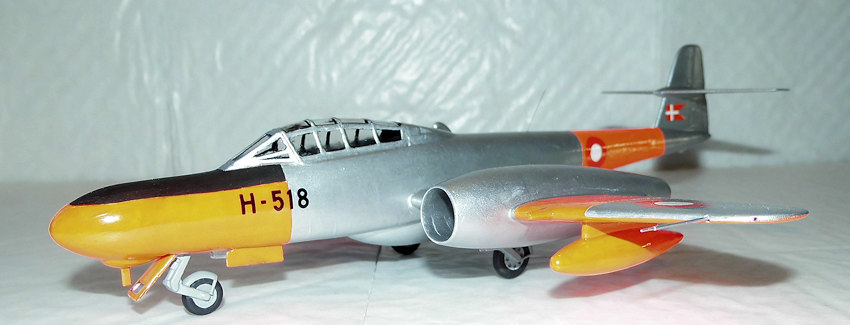
Matchbox 1/72
Meteor TT.20
| KIT #: | PK-129 |
| PRICE: | € |
| DECALS: | Three options |
| REVIEWER: | Nicolai Plesberg |
| NOTES: | Used Stoppel decal sheet no 72-164 + kit decals (walkways) for proper Danish markings. Used Airwaves etched detail set for the cockpit. Scratch building of the target tug equipment. |

| HISTORY |
As the role of night fighting at the end of World War II in the RAF had mostly been done by variants of the DeHavilland Mosquito and still was the case just after the war, the war-weary Mosquitos were, however, in need of replacement as their wooden construction began to make maintenance problems. After the Air Ministry had requested several aircraft companies for a replacement, Gloster responded, that it was possible to develop the Meteor into a night fighter.
However, Gloster was much
preoccupied with the Meteor F.8 development and production, so all
responsibility with the development and production was handed over to Armstrong
Whitworth. The construction of the NF.11 was based on the T.7 trainer, but with
the tail of the F.8, outer wings as they
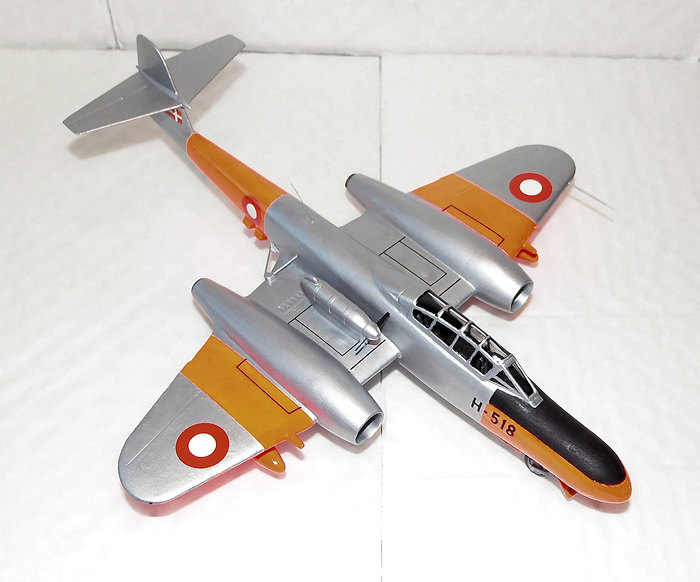 appeared
on the original Meteor design (before they got clipped on the F.Mk.4 and
onwards) and the AI Mk 10 radar set in the lengthened nose. Due to that the
cannon armament had to be moved to the outer wing sections, since there was no
room for them to be retained in the nose section of the aircraft.
appeared
on the original Meteor design (before they got clipped on the F.Mk.4 and
onwards) and the AI Mk 10 radar set in the lengthened nose. Due to that the
cannon armament had to be moved to the outer wing sections, since there was no
room for them to be retained in the nose section of the aircraft.
The Danish government bought 20 Meteor NF.11 with deliveries commencing in November 1952. The aircraft served with Eskadrille 723 (Squadron 723) at Aalborg. In the beginning they were painted as machines serving with the RAF, i.e. Medium Sea Grey all over with a disruptive Dark Green camouflage pattern on the upper surfaces. The aircrafts numbers were 51 as type numeral and individual numbers running from 501 to 520, all in RAF style numbers. When IRAN inspections came up they were repainted in the same scheme as the other Danish Meteor variants (Medium Sea Grey / Dark Sea Grey / Dark Green) and numerals were changed to Danish standard style.
Of the 20 delivered Meteor NF.11 four where lost in crashes, but the service time became rather short because they were already being replaced by the North American F-86 D Sabre in 1958-59. However, six of the NF.11s (the airframes with the lowest flight hours logged) survived to be converted into target tugs as TT.Mk.20s. The last flight of a Danish NF.11 took place on the 31st of May 1959. Surviving airframes (with exception of the TT.20s of course) were all scrapped. However, the TT.20s served with target tug duties, until the fall of 1962, the last flight of a TT.20 took place in September 1962. Five of the six TT.20 were then sold to the Swedish firm Svensk Flygtjänst AB, which carried out target tug duties for the Swedish air force for a number of years in the 60s. The remaining TT.20, H-504, was converted back to NF.11 standard and repainted in the night fighter scheme, however its internal equipment was removed, such as cockpit instruments, engines etc. presumably to act as a source of spare parts of the five aircraft sold to Sweden.
| THE KIT |
The complaint I have heard / read about Matchbox’s own releases of this kit that parts were festooned with sink marks or even parts were only partially molded, due to insufficient injection pressure, which made construction nearly impossible. Later on they apparently had increased the injection pressure in the mold, because my kit wasn’t that bad; only a few sink marks were actually present. As I discovered during construction, the left upper wing was a bit warped and it took an effort to straighten it out before gluing the wing together. Another funny thing is that there were in fact included three (!) decal sheets, but it didn’t matter, as it’s all ways a good thing to have a spare set of walkways (so I thought).
| CONSTRUCTION |
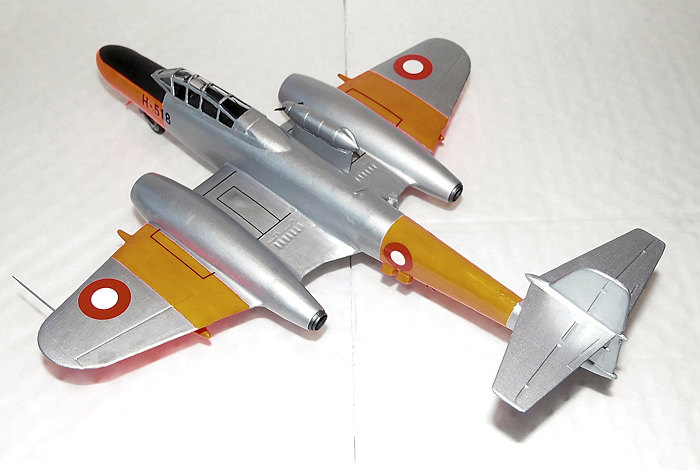 I began
construction by gluing the tail pieces, the nose cone and drop tanks together.
After filling / sanding the seams I glued the pylons to the drop tanks and some
suitable brass tube to the exhaust end of the engine nacelles to improve their
looks. Then it was time to paint a bit; the intakes and main gear bays went
Silver, the engine fronts Flat Black and the exhausts got some burned metallic
look. After two coats and drying time in between I glued the wings together. The
intake pieces were also added at this stage the whole shebang sanded and filled
(as always) by the seams when dry.
I began
construction by gluing the tail pieces, the nose cone and drop tanks together.
After filling / sanding the seams I glued the pylons to the drop tanks and some
suitable brass tube to the exhaust end of the engine nacelles to improve their
looks. Then it was time to paint a bit; the intakes and main gear bays went
Silver, the engine fronts Flat Black and the exhausts got some burned metallic
look. After two coats and drying time in between I glued the wings together. The
intake pieces were also added at this stage the whole shebang sanded and filled
(as always) by the seams when dry.
The next item was the assembling of the interior by gluing the seats in place. I had bought the Airwaves etched set to enhance the looks of the cockpit, but frankly it’s really only in the rear cockpit something can be seen, as it all went Flat Black and the canopy is heavily framed, so…
One piece of advice though; the side panels, especially in the front cockpit needs to have the lower front corners cut down or else it will be very difficult to achieve an acceptable fit when the fuselage parts are glued together. The instructions that Airwaves provide are only a guide line; to achieve an actual fit, the modeler is advised to consult reference material (pictures) of the real thing. Well I had nothing like that, so I had to figure out the best way to get things fit, but it wasn’t that difficult. I found out that the best way to fit the side panels were to glue them to the upper fuselage part with their upper edge in flush with the canopy sill line. Before gluing the fuselage halves together, I filled the nose in front of the interior with lead; the nose cone was also filled up with lead to make sure of a non tail-sitting model. Upon having glued the fuselage together, it was time for some sanding / filling of the seams.
When the main fuselage had been finished
I glued the nosecone in place, but be careful here, as the fit is a bit sloppy.
To aid the alignment of the nose I fastened the windscreen and canopy to the
fuselage with adhesive tape. At this stage I realised, that I had made an error.
The intake pieces of the engine nacelles w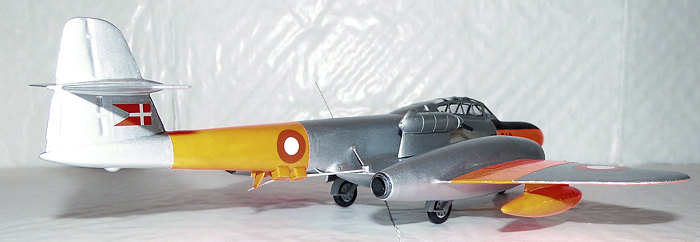 ere
the small bore, as the instructions had shown, but in reality all Danish Meteor
NF.11s / TT.20s were equipped with large bore intakes (so I found out later!).
If I had known that in time, I would of course have used the large bore intakes.
However, I found out it was no big deal to modify the small bore to large bore
intakes simply by removing 3 mm of the edges and sanding them to shape. At this
stage I also removed the cannon muzzles and the ejector chutes, because the
TT.20 was unarmed.
ere
the small bore, as the instructions had shown, but in reality all Danish Meteor
NF.11s / TT.20s were equipped with large bore intakes (so I found out later!).
If I had known that in time, I would of course have used the large bore intakes.
However, I found out it was no big deal to modify the small bore to large bore
intakes simply by removing 3 mm of the edges and sanding them to shape. At this
stage I also removed the cannon muzzles and the ejector chutes, because the
TT.20 was unarmed.
After retouching the intakes with silver paint, the wings were prepared (ensuring a perfect fit as possible) to be attached to the fuselage, as was the complete tail unit. Regarding the tail unit, I found out, that by gluing a piece of sheet at the end of the main fuselage and trimming the edge very precisely, I could achieve that the tail would literally “slip” on and at the same time be perfect aligned with the rest of the aircraft seen from all angels. When all this was accomplished the wings and tail unit were glued to the fuselage. The last action done on the airframe was the filling and sanding of all wing / fuselage / tail seams plus the inevitably other imperfections still around the airframe.
The next issue around was the landing gear units; parts removed form the sprues, cleaned up and assembled. The gear was painted Medium Sea Grey (Humbrol 165), the tires went Black (Xtracolor X505). I also added the supporting struts for the splash guards made from stretched sprue, which also were painted grey afterwards.
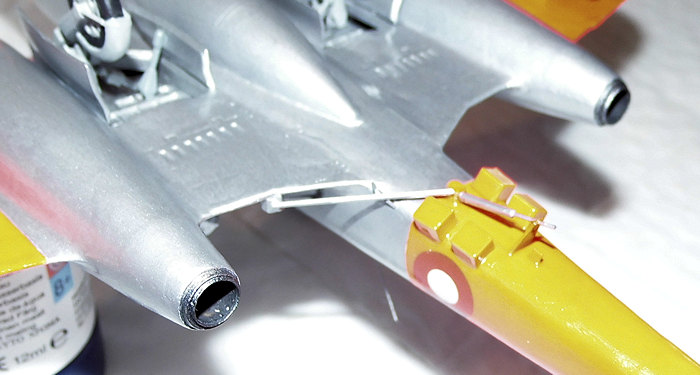 I then
removed the windscreen / canopy (which to at this point have still been taped to
the fuselage to prevent dirt going into the cockpit as well as aiding alignment
of the nose cone). As the radar also had been removed, there was no need for the
radar scope station so these parts were omitted and I glued a piece of sheet
over the opening; however, the Airwaves set gives you an instrument panel for
the target operator’s station of the TT.20 variant, so a piece of sheet was cut
out, the etched part glued on, painted and attached in the rear cockpit.
I then
removed the windscreen / canopy (which to at this point have still been taped to
the fuselage to prevent dirt going into the cockpit as well as aiding alignment
of the nose cone). As the radar also had been removed, there was no need for the
radar scope station so these parts were omitted and I glued a piece of sheet
over the opening; however, the Airwaves set gives you an instrument panel for
the target operator’s station of the TT.20 variant, so a piece of sheet was cut
out, the etched part glued on, painted and attached in the rear cockpit.
After the last detail painting, I cleaned and glued the clear parts in place using Humbrol Gloss Cote. Eventual gaps were also filled with Gloss Cote and given a light sanding down when dry. The fit of the canopy was much better here as the parts constituting the radar station didn’t collide with the thick canopy simply because they were omitted.
The next step was a complete clean up of the airframe removing all sanding dust / fingerprints. Then the drop tanks / pylons and the belly tank were glued in place; also filling the gaps from these items. The gear was then attached with a slow setting CA glue and the last thing done, before the model went to the paint shop, was to paint the canopy frames flat black together with the anti-glare panel in front of the windscreen.
| COLORS & MARKINGS |
The Danish TT.20s was painted
aluminum (so don’t break out the Alclad here –
unnecessary!) over the original paint scheme with dayglo orange areas on nose /
fuselage and wings. As I have read in several old modelling magazines to obtain
a perfect natural metal surface it’s a good idea to prime the surface with white
and since white is also the primer for fluorescent orange it meant that the
whole model would be painted white. First I masked off the anti-glare panel
(including the canopy framing), as this should stay black as it already was, and
then the whole model was given three coats of flat white with drying time in
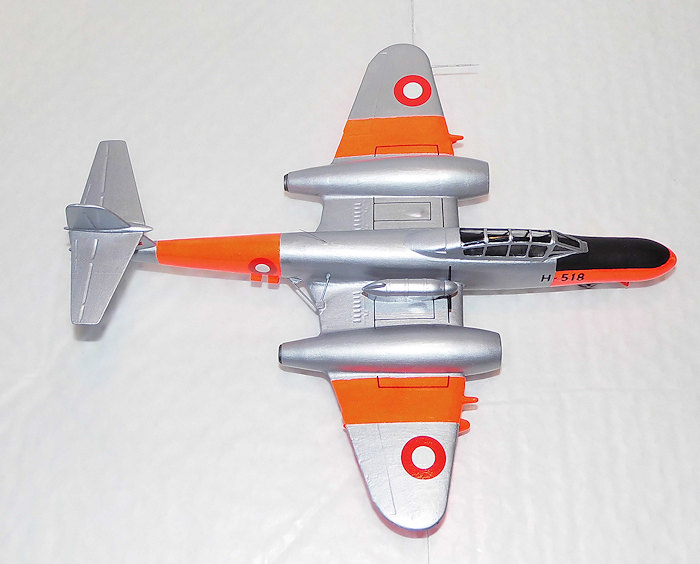 between;
the flat sheen being necessary to ensure good adhesion for the fluorescent
orange as well as the silver paint.
between;
the flat sheen being necessary to ensure good adhesion for the fluorescent
orange as well as the silver paint.
Then I masked off the areas which should be painted fluorescent orange and six coats were painted (including the outer side of nose gear doors) with drying time in between. The masking tape was removed immediately after the sixth coat had been applied. When all the orange had dried thoroughly the inner surface of gear doors, nose gear bay, canopy frames, upper surface of outer wing sections plus the tail (behind the rear fuselage orange band) was given a coat of silver (Humbrol 11). The funny part is, that it was almost enough due to the primer coat of white. I have several times in the past painted two and three coats of silver paint on the bare plastic surface before the coverage got acceptable though not perfect, which means the undercoat of white is a good idea.
After a second coat of silver on the aforementioned areas and drying time the remainder of the fuselage plus inner sections of wings and engine nacelles was given two coats of silver with drying time in between. The last thing remaining was the fixing of the demarcation lines, i.e. scraping / sanding the edges down and tedious touch up sessions followed, but in the end I got the crack on things and finalized with an all over coat of gloss to prepare for the decals.
The decals went down with pretty much ease, but to the difference from my other
Meteor builds, the decals were in
perfect register. The kit decals
provided the walkways, which was prominent on the real planes. Regarding the
walkways; Matchbox had actually done a quite genius job here. On all the
Meteors, that I have build, only the Matchbox walk ways had a hole in the
carrier film, because there is a nasty bulge (related to the retracted gear) on
the upper surface of the inner wing, which the Matchbox decal went over with e ase,
while on the other kits, I had to remove the carrier film with a sharp (new)
scalpel blade, because it was impossible for me to get the carrier film over the
bulges to conform perfect (with the exception on my Meteor F.4 and NF.11).
ase,
while on the other kits, I had to remove the carrier film with a sharp (new)
scalpel blade, because it was impossible for me to get the carrier film over the
bulges to conform perfect (with the exception on my Meteor F.4 and NF.11).
When the decals had dried and after a cleaning session with a moist anti-static cloth to remove eventual decal glue residue / dust particles they got a coat of gloss to secure them. As I suspected the target tugs, due to the nature of their mission, was kept in a glossy look to be as highly visible to the attacking aircraft or AAA gunners as possible, I decided to keep it that way. At this stage I also marked the position lights, as I did this build in parallel with my other Meteor builds.
| FINAL CONSTRUCTION |
The remaining parts were the recognizing features of the TT.20: the wind driven wire mill located on the starboard inner wing, the target containers below the rear fuselage, the wire cutter together with two reels and tubing to guide the target wire from the mill to under the rear fuselage so that nothing was in the way for the wire and target.
The mill
plus its plinth came first. It was made of several large chunks of plastic cut
out of 3 – 4 mm thick plastic sheet and sanded to shape then glued together.
Detail consisted of thin strips of Tamiya tape cut out and wrapped around on the
mill housing. The “outgrowth” on the rear of the housing was a separate piece of
plastic sanded to shape then glued in place. The spinner of the propeller was a
suitable piece of sprue sanded to shape and to tiny holes (0.5 mm) drilled to
house the prop blades, which were cut out of 0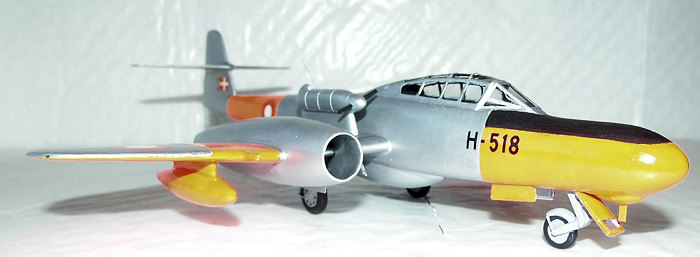 .3
mm sheet. The blades were cut into shape and then glued to the spinner. The mill
housing / plinth plus spinner were painted silver while the blades went flat
black.
.3
mm sheet. The blades were cut into shape and then glued to the spinner. The mill
housing / plinth plus spinner were painted silver while the blades went flat
black.
The next in line were the four target containers sitting below the rear fuselage. They were also made of some thick plastic pieces cut and sanded to shape then glued in place with slow setting CA-glue. The remaining details were made of stretched sprue, more chunks of plastic cut into shape and various size bits cut to match what the crude sketch drawing I had at my disposal showed. Finally I had cracked the code and got all things in place, so left was to paint the added details in their respective colors (silver / fluorescent orange).
The final bits consisted of attaching the gear doors and various antennas with CA-glue and painted their respective colors when the CA-glue had set. The last thing attached was the mill housing / plinth glued carefully to the starboard inner wing section and a slight touch up with silver paint between the plinth and the wing surface and after attaching the propeller to the mill housing, via an axle I had glued to the spinner, the model was finished.
| CONCLUSIONS |
What can I say else than this variant of the Meteor that is probably the most difficult to build since it requires a degree of skill in scratch building, as the additions are not available as aftermarket items. As this kit has its hassles with fit / alignment issues some experience is definitely needed, but if the skills are present it builds into a beautiful model. This conversion is only recommended to the skilled modelers above average.
| REFERENCES |
The publication Forsvarets fly efter 1945 (Planes of the Danish armed forces after 1945) published by RDAF / tinbox, 1987 edition, was very helpful.
Also an article of IPMS-nyt no 119 (the Danish IPMS branch’s membership magazine) provided some inspiration, among them a couple of photos of TT.20s and as mentioned earlier a crude sketch drawing where you see all the hardware under the rear fuselage from about 4 - 5 o’clock position: www.ipms.dk/IPMS-nyt/IPMS-Nyt%20119.pdf
...but I guess a better drawing / photos can without doubt be found elsewhere...; because I really had a hard time trying to decipher how to construct the additions, especially those located under the rear fuselage, from those limited resources! Do yourself a favor; try to look out some better material than I had at my disposal, because I’m convinced that it is in existence out there somewhere – it will be worth it!
May 2016
Copyright ModeingMadness.com
If you would like your product reviewed fairly and fairly quickly, please contact the editor or see other details in the Note to Contributors.